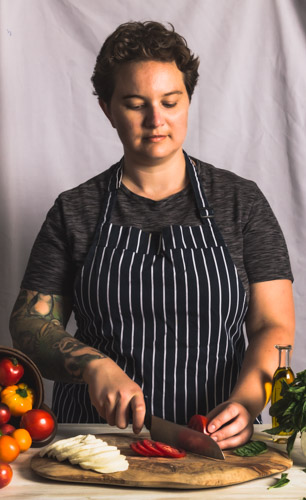
Hi, I’m Quin. Non-binary, autistic, queer, and interesting sarcastic. I’m a molecular biologist by training, sometime wildlife researcher, and seasonal recipe developer and photographer with lots of four-footed kitchen un-helpers.
Learn more about how I got started in the kitchen with food science below or get inspired with these suggestions.
I enjoy having fun with food – not a silly or whimsical sense, but enjoying innovating in the kitchen. Preferably with a drink in hand. And not in an overly molecular gastronomically way, but just finding new combinations or enjoying the process of invention. While I did get into food science because of molecular gastronomy, I learned to appreciate that all cooking was a combination of the sciences.
I took an awesome class while I was at university (totally non-serious, just a couple credits) called Chemistry of Cooking. I loved it. Imagine a bunch of biology, chemistry, and physic nerds in a kitchen, cooking. Then writing [silly] lab reports. We had so much fun and learned a lot more outside our fields than we would have in the required classes.
Yes, we all got into it because of concepts like spherification and nitrogen freezing, but the actual basics are so much more fun. (Ok, I would still exploit my chemistry dept. contacts for liquid nitrogen ice cream; no water/ice = the creamiest ice cream you have ever tasted). But explaining the basics of yeast production and caramelization to you is a lot of fun for me. As is describing my love of tomatoes. And why not? This is a blog and you are here for the love of tasty food.
So let’s play in kitchen together, whether scientifically or just throwing flour at the walls (sometimes one and the same), and find great flavour combinations and new ways to approach old standards. And try not to step on the cats. They really like getting under foot.
Let’s talk measurement conversions
For a lot of my measurements I go for weight (g based). But because I’m in the US currently (as are most of the people reading this) I do a lot of volumes as well.
Probably 90% of my fruit/vegetable/nut/herb weights are from direct measurements while a lot of the flour/additive weights are from the King Arthur weight conversion charts (and occasionally others, Annabel Langbein has a good one that includes temperatures). Honestly, if you want to follow my recipes as closely as possible, go by the volumetric measures for dry components and weights for produce and the like.
